- Joined
- Sep 13, 2021
- Messages
- 1,450
What: I've been meaning to do this for at least 6 months, so last night I finally sat down and made my Buck 250 Slim Saunter. Removing the liners reduced the weight by a full ounce from 2.3 to 1.3 - that's more than a 40% reduction - and got it under 40 grams. I didn't measure the starting thickness, but the Slim Saunter ended up at a svelte 3/8ths of an inch. The reduction was on the order of 1/16th of an inch, which is over 16% slimmer.
Why: But who cares about numbers. The result is a knife that looks and feels great in the hand, and absolutely disappears in a pocket. It will carry much nicer in my suit coat pocket. On Sunday's I rotate between gentleman's knives including things such as Buck's 704 Mavericks (both wood and a factory stag), a 503 my father gave me in middle school (one of my first two Bucks along with a 110 from my grandfather), a single-blade 301, a Lone Wolf Knives Paul Executive, one of my grandfather's old Barlows that is the thinnest I've seen, and now my slim Saunter. Before going on a diet, the Saunter always felt like a chunk in the suit pocket. It wasn't really, it just felt to me like it could have been made a little slimmer like the 700 series. I considered thinning the Micarta scales, but then looked at my 110 and 112 Slim Pros. They function great with just Micarta scales and no liners supporting the blade, so I figured that would work for the Saunter, as well.
How: Instead of keeping the sharpened edge off the spring with a traditional kick like most slipjoints, the choil of the Saunter rests against a stop pin when closed. The stop pin is held by holes in the liners, and is held captive by the Micarta scales; there are no holes in the scales. So to remove the liners, you have to drill holes in the scales to the proper depth. If you go too deep you risk the pin drifting too far to one side and popping out of the hole in the scale on the other side. Don't ask me how I know. There may, or may not, be the smallest sliver of shaved toothpick in the bottom of one of the holes to fill it back in. And if you really go too deep, you'll pop out the other side of the scale. I aligned the drill by holding both liners to the scale being drilled with the three well nuts. The pilot of my number 2 spotting drill was the absolute PERFECT diameter, and also plenty long enough before getting into the shoulder. The next task is shortening the three well nuts and the bolts. Note the counterbore in the well nuts to accept the unthreaded shank of the bolts (the threads don't go all the way to the head - there is a short, unthreaded section). Note that the well nuts have a flat. Rotation is prevented by the holes with flats in the liners. Removing the liners to make a Slim Saunter means you will lose this feature and the well nuts can spin. Consequently I didn't re-assemble with LockTite - which is perfectly fine for my uses of this knife as a gentleman's suit coat pocket knife. I shortened the two rear well nuts and counterbored them enough so that I can tighten them down all the way. The head of the well nuts grab against the Micarta allowing them to be snugged up nicely. Through trial and error, I snuck up on the length of the pivot well nut to where I can tighten it fully so that the bolt bottoms out in the well nut with proper force on the scales and blade to allow nice slipjoint action without squeezing them too tightly, and without permitting any side-to-side blade wiggle. That allows me to snug it up enough to stay tight without LockTite, without pinching the blade between the scales too much.
There may, or may not, be the smallest sliver of shaved toothpick in the bottom of one of the holes to fill it back in. And if you really go too deep, you'll pop out the other side of the scale. I aligned the drill by holding both liners to the scale being drilled with the three well nuts. The pilot of my number 2 spotting drill was the absolute PERFECT diameter, and also plenty long enough before getting into the shoulder. The next task is shortening the three well nuts and the bolts. Note the counterbore in the well nuts to accept the unthreaded shank of the bolts (the threads don't go all the way to the head - there is a short, unthreaded section). Note that the well nuts have a flat. Rotation is prevented by the holes with flats in the liners. Removing the liners to make a Slim Saunter means you will lose this feature and the well nuts can spin. Consequently I didn't re-assemble with LockTite - which is perfectly fine for my uses of this knife as a gentleman's suit coat pocket knife. I shortened the two rear well nuts and counterbored them enough so that I can tighten them down all the way. The head of the well nuts grab against the Micarta allowing them to be snugged up nicely. Through trial and error, I snuck up on the length of the pivot well nut to where I can tighten it fully so that the bolt bottoms out in the well nut with proper force on the scales and blade to allow nice slipjoint action without squeezing them too tightly, and without permitting any side-to-side blade wiggle. That allows me to snug it up enough to stay tight without LockTite, without pinching the blade between the scales too much.
So, that's it: my Buck 250 Slim Saunter. I finished up late last night after the kids were in bed and snapped some quick pictures. I'll try to get some nicer pictures soon, but we have company coming this weekend, so it might be a while before I get to it. Who else has modded a Saunter? I'd love to see some elk, stag, a Yellowhorse, jigged bone, nice woods like rosewood, ironwood, walnut, etc. The screwed construction and the flat-backed liners - not carved out like Demko AD20.5's, or Spyderco PM3's and such - make this little knife ripe for modifications to turn it from a solid everyday slipjoint into a really classy gentleman's knife.
Take this as a challenge - let's see some modified Saunters!



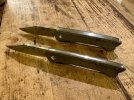
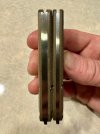
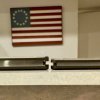
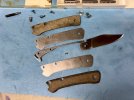
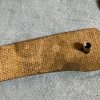
Why: But who cares about numbers. The result is a knife that looks and feels great in the hand, and absolutely disappears in a pocket. It will carry much nicer in my suit coat pocket. On Sunday's I rotate between gentleman's knives including things such as Buck's 704 Mavericks (both wood and a factory stag), a 503 my father gave me in middle school (one of my first two Bucks along with a 110 from my grandfather), a single-blade 301, a Lone Wolf Knives Paul Executive, one of my grandfather's old Barlows that is the thinnest I've seen, and now my slim Saunter. Before going on a diet, the Saunter always felt like a chunk in the suit pocket. It wasn't really, it just felt to me like it could have been made a little slimmer like the 700 series. I considered thinning the Micarta scales, but then looked at my 110 and 112 Slim Pros. They function great with just Micarta scales and no liners supporting the blade, so I figured that would work for the Saunter, as well.
How: Instead of keeping the sharpened edge off the spring with a traditional kick like most slipjoints, the choil of the Saunter rests against a stop pin when closed. The stop pin is held by holes in the liners, and is held captive by the Micarta scales; there are no holes in the scales. So to remove the liners, you have to drill holes in the scales to the proper depth. If you go too deep you risk the pin drifting too far to one side and popping out of the hole in the scale on the other side. Don't ask me how I know.
So, that's it: my Buck 250 Slim Saunter. I finished up late last night after the kids were in bed and snapped some quick pictures. I'll try to get some nicer pictures soon, but we have company coming this weekend, so it might be a while before I get to it. Who else has modded a Saunter? I'd love to see some elk, stag, a Yellowhorse, jigged bone, nice woods like rosewood, ironwood, walnut, etc. The screwed construction and the flat-backed liners - not carved out like Demko AD20.5's, or Spyderco PM3's and such - make this little knife ripe for modifications to turn it from a solid everyday slipjoint into a really classy gentleman's knife.
Take this as a challenge - let's see some modified Saunters!








